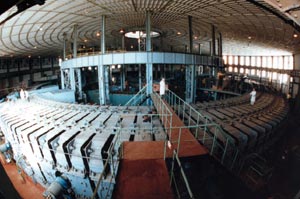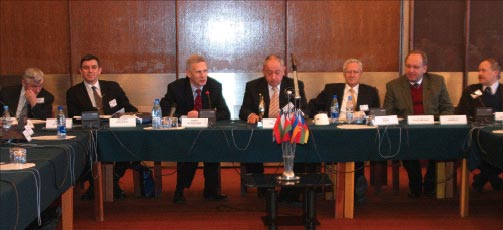This month the Joint Institute for Nuclear Research celebrates its 50th anniversary as a renowned international intergovernmental scientific research organization.

The Joint Institute for Nuclear Research (JINR) was established through a convention signed in Moscow on 26 March 1956 by representatives from 11 founder states. Their aim was to unite their scientific and material potential in order to study the fundamental properties of matter. Nearly a year later, on 1 February 1957 the institute was registered with the United Nations.
JINR is situated in Dubna, 120 km north-east of Moscow on the Volga River. It is known today around the world as a centre where fundamental research, both theoretical and experimental, is successfully integrated with new technology, the latest techniques and university education.
The main fields of JINR’s research are theoretical and experimental studies in elementary-particle physics, nuclear physics, and condensed-matter physics. The research programme is aimed at obtaining highly significant scientific results. In nuclear physics alone, around half the 80 or so discoveries in the former USSR were made at JINR. The decision of the General Assembly of the International Committee of Pure and Applied Chemistry to award the name Dubnium to element 105 of the periodic table stands in recognition of the achievements of the institute’s researchers and their contribution to modern physics and chemistry.
At present JINR has 18 member states: Armenia, Azerbaijan, Belarus, Bulgaria, Cuba, Czech Republic, Georgia, Kazakhstan, Democratic People’s Republic of Korea, Moldova, Mongolia, Poland, Romania, Russia, Slovakia, Ukraine, Uzbekistan and Vietnam. Germany, Hungary, Italy and the Republic of South Africa also participate in JINR’s activities through bilateral agreements signed at governmental level.
JINR is a genuinely international institution. Its supreme governing body is the Committee of Plenipotentiaries of all 18 member states. The research policy is determined by the Scientific Council, which consists of eminent scientists from the member states, as well as well known researchers from France, Germany, Italy, the US and CERN.
From firm foundations
Since its beginnings, JINR has instigated a wide range of research, and scientific personnel of the highest qualification have been trained for the institute’s member states. Among them are presidents of national academies of sciences, along with leaders of large nuclear centres and universities in many of the member states.
Before JINR’s foundation, the Institute of Nuclear Problems (INP) of the USSR Academy of Sciences had been set up in the late 1940s in the town that was to grow into modern Dubna. The INP had launched a broad research programme on fundamental and applied studies of the properties of nuclear matter using what was at the time the largest charged-particle accelerator – the synchrocyclotron. At the same time, the Electrophysical Laboratory (EPhLAN) of the USSR Academy of Sciences was set up at the same place and it was here that research to develop a new accelerator – the 10 GeV Synchrophasotron (figure 2) – was conducted under the guidance of Vladimir Veksler. When this machine started up in 1957 it was the world’s highest-energy accelerator.

By the mid-1950s the world had come to realize that nuclear science could not be kept locked in secret laboratories and that only broad-based international co-operation could ensure progress in this fundamental realm of human knowledge and in the peaceful utilization of atomic energy. In 1954 CERN was established to unite the efforts of Western European countries in studying the fundamental properties of the microcosm. About the same time, under the stimulus of the government of the USSR, the countries then belonging to the socialist world took a decision to establish JINR, based on the INP and EPhLAN.
After the agreement for the foundation of JINR was signed, specialists from all the member states came to Dubna. As the town took on its international flavour, research began in many fields of nuclear physics of interest to the scientific centres of the member states. The first director of JINR was Dmitri Blokhintsev (figure 3), who had just successfully developed the world’s first atomic power station in Obninsk. Marian Danysz from Poland and Vaclav Votruba from Czechoslovakia became vice-directors, and together this first directorate led the institute through one of the most difficult and crucial periods in its life – the time of its establishment.

The history of JINR is associated with many outstanding scientists including Nikolai Bogoliubov, Igor Kurchatov, Igor Tamm, and Lajos Janossy. Many others were involved in developing the institute and its main scientific branches, such as Alexander Baldin, Vladimir Veksler, Moissey Markov, Bruno Pontecorvo and Georgi Flerov to name but a few.
The institute today

Since JINR’s founding, nuclear research has been marked by important discoveries and crucial changes. In 1961 the JINR Prizes were established, and a group of physicists led by Veksler and Wang Ganchang from China were awarded the first such prize for their discovery of the antisigma-minus-hyperon. No-one doubted at the time that this particle was elementary, but a few years later, this hyperon, the proton, neutron, pion and other hadrons had lost their elementary quality. They turned out to be complex particles consisting of quarks and antiquarks, which have in turn gained the “right” to be called elementary. Physicists at Dubna have clarified to a great extent the concept of the quark structure of hadrons. Among their latest research are the ideas of colour quarks, the hadron quark model known as “the Dubna bag”, and so on.
In addition to this mainstream progress over the past 50 years, there has been another, quite opposite theme – research that was far ahead of its time. Fifty years ago, soon after JINR had been established, Bruno Pontecorvo suggested the existence of neutrino oscillations. It took scientists dozens of years to find experimental confirmation of such oscillations, which are now a central issue of the physics of weak interactions. At the 97th session of the JINR Scientific Council in January 2005 Art MacDonald, director of the Sudbury Neutrino Observatory (SNO) received the Pontecorvo Prize for the discovery in SNO of evidence for solar neutrino oscillations.
JINR publications are distributed in more than 50 countries. About 600 preprints and communications a year are issued
The modern JINR comprises eight laboratories, each being comparable with a large institute in the scale and scope of investigations performed. It employs more than 6000 people, including more than 1000 scientists, including full members and corresponding members of national academies of sciences, more than 260 Doctors of Science and 630 Candidates of Science, and around 2000 engineers and technicians. The current director, as from 1 January 2006, is Alexei Sissakian, with Mikhail Itkis and Richard Lednick as vice-directors.
The institute possesses a remarkable choice of experimental facilities for physics: Russia’s only superconducting accelerator of nuclei and heavy ions, the Nuclotron (figure 4); the U-400 and U-400M cyclotrons with record beam parameters for experiments on the synthesis of heavy and exotic nuclei; the unique neutron pulsed reactor IBR-2; and the Synchrophasotron proton accelerator which is used for radiation therapy. JINR also has powerful and fast computing facilities, which are integrated into the worldwide computer network.
JINR has established excellent conditions for training talented young specialists. Its University Centre organizes research experience annually at the institute’s facilities for students from higher-education institutions in Russia and other countries. In 1994, on the initiative of the JINR directorate, and with the active support of the Russian Academy of Natural Sciences, the town of Dubna and the Moscow region administrations established the Dubna International University of Nature, Society and Man. There are dozens of JINR staff members – all renowned scientists – among the university staff. The university educational base is actively developed on the territory of JINR, so that Dubna has become a town of students as well as physicists.

Each year JINR submits more than 500 scientific papers and reports written by about 3000 authors to the editorial offices of many journals and organizing committees. JINR publications are distributed in more than 50 countries. About 600 preprints and communications a year are issued. JINR publishes the journals Physics of elementary particles and atomic nucleus, Physics of elementary particles and atomic nucleus letters, the annual report on JINR activities, the information bulletin JINR News, as well as proceedings of conferences, schools and meetings organized by the institute.
For 50 years JINR has been a bridge between the West and the East promoting the development of broad international scientific and technical co-operation. It collaborates with nearly 700 research centres and universities in 60 countries. In Russia alone – the largest JINR partner – co-operation is conducted with 150 research centres, universities, industrial enterprises and companies from 40 Russian cities.
A clear example is JINR’s co-operation with CERN, which facilitates decisions about many theoretical and experimental efforts in high-energy physics. JINR is currently participating in the Large Hadron Collider (LHC) project, taking part in development and construction of parts of the ATLAS, CMS and ALICE detector systems and in the LHC itself. Thanks to its supercomputer centre, JINR is also participating in the development of the Russian regional centre for processing experimental data from the LHC, which is planned as part of the LHC Computing Grid project.
International experience

More than 200 scientific centres, universities and enterprises from 10 countries in the Commonwealth of Independent States (CIS) participate in implementing JINR’s scientific programme. The institute may be regarded as a joint scientific centre for the CIS countries, functioning successfully on the international scale. The large and positive experience accumulated at JINR for mutually profitable scientific and technical co-operation on the international scale could provide a discussion topic for a meeting of CIS leaders in Dubna in the context of a summit of the CIS member states.
JINR also maintains mutually beneficial contacts with the IAEA, UNESCO, the European Physical Society and the International Centre for Theoretical Physics in Trieste. Each year more than 1000 scientists from JINR’s partner states visit Dubna, and the institute grants scholarships to physicists from developing countries. JINR’s own researchers are frequent participants at many national and international scientific conferences. In its turn, the institute annually holds up to 10 large conferences and more than 30 international workshops, as well as traditional schools for young scientists.
In the late 1990s, the concept of JINR as a large multidisciplinary international centre for fundamental research in nuclear physics and related fields of science and technology was adopted. The aim is to transfer the results of highly technological research at JINR to applications in industrial, medical and other technical areas, so as to provide additional sources of financing for fundamental research and the organization of new working places for specialists who are involved with these broader topics at the institute. There are also plans for assisting JINR member states to develop new facilities and scientific programmes, such as a cyclotron centre in Bratislava in the Slovak Republic and the DC-60 cyclotron in Astana in Kazakhstan.
JINR has thus entered the 21st century as a large multidisciplinary international scientific centre where fundamental research is conducted in fields related to the structure of matter. It is now integrated with the development and application of new science-intensive technology and the development of university education in related fields of science and it looks forward to its next half century.





